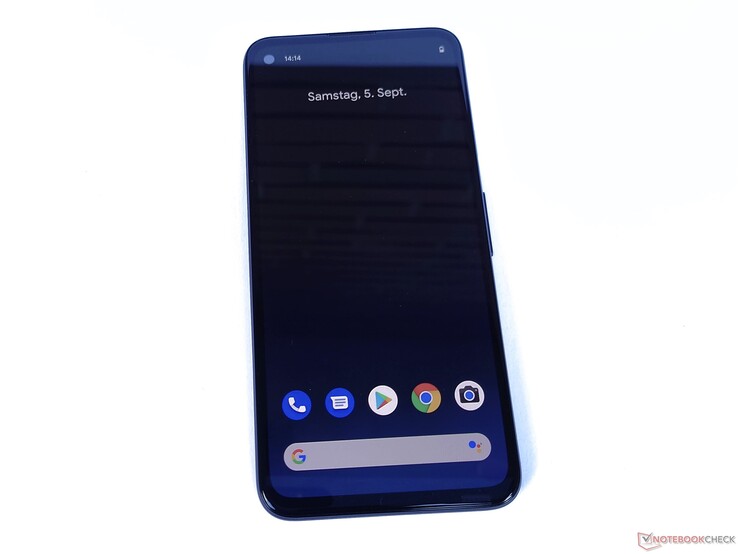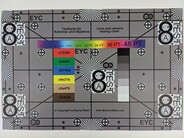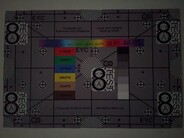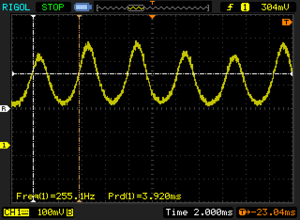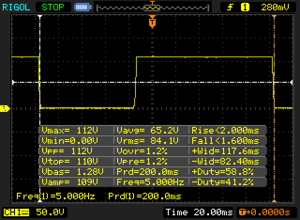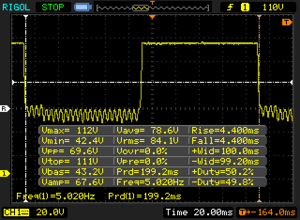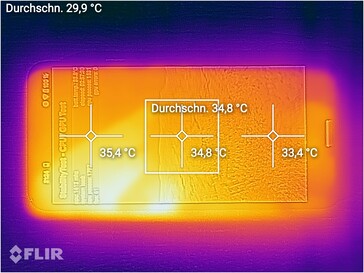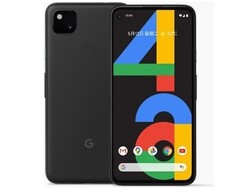Google Pixel 4a smartphone rövid értékelés: Nem a megapixelekről szól
Comparison devices
Értékelés | Dátum | Modell | Súly | Drive | Méret | Felbontás | Legjobb ár |
|---|---|---|---|---|---|---|---|
| 83.6 % v7 (old) | 12/2020 | Google Pixel 4a SD 730G, Adreno 618 | 143 g | 128 GB UFS 2.0 Flash | 5.80" | 2340x1080 | |
| 85.2 % v7 (old) | 04/2020 | Apple iPhone SE 2020 A13 Bionic, A13 Bionic GPU | 148 g | 128 GB NVMe | 4.70" | 1334x750 | |
| 78.6 % v7 (old) | 05/2020 | Sony Xperia 10 II SD 665, Adreno 610 | 151 g | 128 GB eMMC Flash | 6.00" | 2520x1080 | |
| 79.8 % v7 (old) | 03/2020 | Samsung Galaxy M31 Exynos 9611, Mali-G72 MP3 | 191 g | 64 GB UFS 2.0 Flash | 6.40" | 2340x1080 | |
| 82.9 % v7 (old) | 12/2020 | Xiaomi Mi Note 10 Lite SD 730G, Adreno 618 | 204 g | 64 GB UFS 2.0 Flash | 6.47" | 2340x1080 |
| Networking | |
| iperf3 transmit AX12 | |
| Apple iPhone SE 2020 | |
| Google Pixel 4a | |
| Sony Xperia 10 II | |
| Xiaomi Mi Note 10 Lite | |
| Samsung Galaxy M31 | |
| iperf3 receive AX12 | |
| Google Pixel 4a | |
| Apple iPhone SE 2020 | |
| Xiaomi Mi Note 10 Lite | |
| Samsung Galaxy M31 | |
| Sony Xperia 10 II | |
» A Top 10 multimédiás noteszgép - tesztek alapján
» A Top 10 játékos noteszgép
» A Top 10 belépő szintű üzleti noteszgép
» A Top 10 üzleti noteszgép
» A Top 10 notebook munkaállomása
» A Top 10 okostelefon - tesztek alapján
» A Top 10 táblagép
» A Top 10 Windows tabletje
» A Top 10 subnotebook - tesztek alapján
» A Top 10 300 euró alatti okostelefonja
» A Top 10 120 euró alatti okostelefonja
» A Top 10 phabletje (>5.5-inch)
» A Top 10 noteszgép 500 EUR (~160.000 HUF) alatt
» A Top 10 "pehelysúlyú" gaming notebookja
Kép összehasonlítás
Válasszon egy jelenetet, és navigáljon az első képen belül. Érintőképernyőkön egy kattintással megváltoztathatja a pozíciót. Egy kattintás a kinagyított képre megnyitja az eredetit egy új ablakban. Az első képen a tesztkészülék méretarányos fotója látható.
Main camera (rabbit)Main camera (flower)Zoom (5x)Low light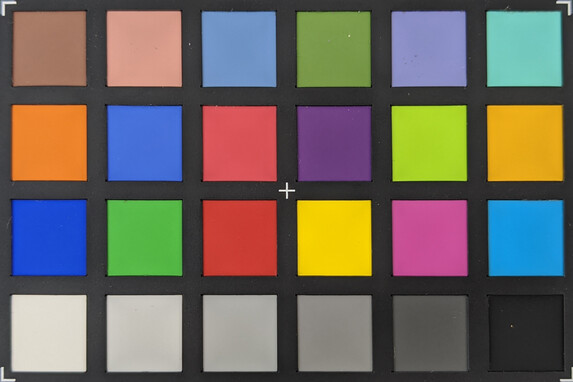
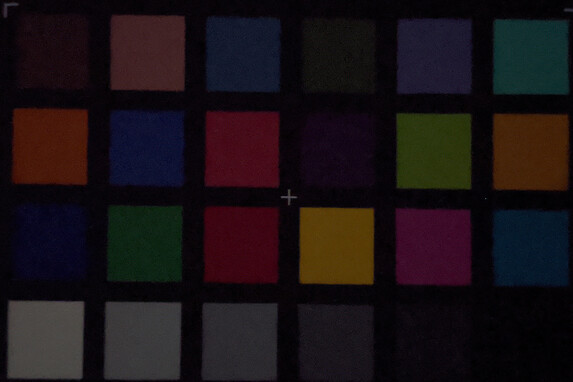
| |||||||||||||||||||||||||
Fényerő megoszlás: 96 %
Centrumban: 705 cd/m²
Kontraszt: ∞:1 (Fekete: 0 cd/m²)
ΔE ColorChecker Calman: 0.9 | ∀{0.5-29.43 Ø4.78}
ΔE Greyscale Calman: 1.3 | ∀{0.09-98 Ø5}
95.3% sRGB (Calman 2D)
Gamma: 2.26
CCT: 6576 K
| Google Pixel 4a OLED, 2340x1080, 5.8" | Apple iPhone SE 2020 IPS, 1334x750, 4.7" | Sony Xperia 10 II OLED, 2520x1080, 6" | Samsung Galaxy M31 Super AMOLED, 2340x1080, 6.4" | Xiaomi Mi Note 10 Lite AMOLED, 2340x1080, 6.5" | |
|---|---|---|---|---|---|
| Screen | -12% | -46% | -85% | -3% | |
| Brightness middle (cd/m²) | 705 | 688 -2% | 591 -16% | 622 -12% | 605 -14% |
| Brightness (cd/m²) | 707 | 659 -7% | 590 -17% | 615 -13% | 608 -14% |
| Brightness Distribution (%) | 96 | 92 -4% | 97 1% | 97 1% | 95 -1% |
| Black Level * (cd/m²) | 0.28 | ||||
| Colorchecker dE 2000 * | 0.9 | 1 -11% | 1.42 -58% | 2.25 -150% | 0.84 7% |
| Colorchecker dE 2000 max. * | 1.9 | 2.2 -16% | 3.83 -102% | 6.22 -227% | 1.8 5% |
| Greyscale dE 2000 * | 1.3 | 1.7 -31% | 2.4 -85% | 2.7 -108% | 1.3 -0% |
| Gamma | 2.26 97% | 2.25 98% | 2.215 99% | 2.019 109% | 2.211 100% |
| CCT | 6576 99% | 6790 96% | 9014 72% | 6810 95% | 6310 103% |
| Contrast (:1) | 2457 |
* ... a kisebb jobb
Képernyő villogása / PWM (impulzusszélesség-moduláció)
| Képernyő villogása / PWM észlelve | 255.1 Hz | ≤ 99 % fényerő beállítása | |
A kijelző háttérvilágítása 255.1 Hz-en villog (a legrosszabb esetben, pl. PWM használatával) Villódzás észlelve a 99 % vagy annál kisebb fényerő-beállításnál. E fényerő-beállítás felett nem lehet villogás vagy PWM. A 255.1 Hz frekvenciája viszonylag magas, így a legtöbb PWM-re érzékeny felhasználó nem észlel semmilyen villogást. Vannak azonban jelentések, amelyek szerint egyes felhasználók még mindig érzékenyek a PWM-re 500 Hz-en és magasabb frekvencián, ezért ügyeljen rá. Összehasonlításképpen: az összes tesztelt eszköz 53 %-a nem használja a PWM-et a kijelző elsötétítésére. Ha PWM-et észleltek, akkor átlagosan 8091 (minimum: 5 - maximum: 343500) Hz-t mértek. | |||
Megjelenítési válaszidők
| ↔ Válaszidő Fekete-fehér | ||
|---|---|---|
| 3.6 ms ... emelkedés és süllyedés ↘ kombinálva | ↗ 2 ms emelkedés | |
| ↘ 1.6 ms ősz | ||
| A képernyő tesztjeinkben nagyon gyors reakciósebességet mutatott, és nagyon jól használható gyors tempójú játékokhoz. Összehasonlításképpen, az összes tesztelt eszköz 0.1 (minimum) és 240 (maximum) ms között mozog. » 14 % of all devices are better. Ez azt jelenti, hogy a mért válaszidő jobb, mint az összes vizsgált eszköz átlaga (20.2 ms). | ||
| ↔ Válaszidő 50% szürke és 80% szürke között | ||
| 8.8 ms ... emelkedés és süllyedés ↘ kombinálva | ↗ 4.4 ms emelkedés | |
| ↘ 4.4 ms ősz | ||
| A képernyő gyors reakciósebességet mutat tesztjeinkben, és játékra is alkalmasnak kell lennie. Összehasonlításképpen, az összes tesztelt eszköz 0.165 (minimum) és 636 (maximum) ms között mozog. » 21 % of all devices are better. Ez azt jelenti, hogy a mért válaszidő jobb, mint az összes vizsgált eszköz átlaga (31.6 ms). | ||
| PCMark for Android | |
| Work performance score (érték szerinti rendezés) | |
| Google Pixel 4a | |
| Sony Xperia 10 II | |
| Samsung Galaxy M31 | |
| Xiaomi Mi Note 10 Lite | |
| Átlagos Qualcomm Snapdragon 730G (8941 - 10200, n=7) | |
| Work 2.0 performance score (érték szerinti rendezés) | |
| Google Pixel 4a | |
| Sony Xperia 10 II | |
| Samsung Galaxy M31 | |
| Xiaomi Mi Note 10 Lite | |
| Átlagos Qualcomm Snapdragon 730G (7134 - 8683, n=7) | |
| AnTuTu v8 - Total Score (érték szerinti rendezés) | |
| Google Pixel 4a | |
| Apple iPhone SE 2020 | |
| Sony Xperia 10 II | |
| Samsung Galaxy M31 | |
| Xiaomi Mi Note 10 Lite | |
| Átlagos Qualcomm Snapdragon 730G (251673 - 275660, n=6) | |
| Jetstream 2 - 2.0 Total Score | |
| Az osztály átlaga Smartphone (23.8 - 387, n=149, az elmúlt 2 évben) | |
| Apple iPhone SE 2020 (Safari Mobile 13.1) | |
| Google Pixel 4a (Chrome 85) | |
| Átlagos Qualcomm Snapdragon 730G (45.8 - 50.6, n=6) | |
| Xiaomi Mi Note 10 Lite (Chrome 83.0.4103.106) | |
| Samsung Galaxy M31 (Chrome 83) | |
| JetStream 1.1 - Total Score | |
| Apple iPhone SE 2020 (Safari Mobile 13.1) | |
| Google Pixel 4a (Chrome 85) | |
| Átlagos Qualcomm Snapdragon 730G (79.2 - 87.7, n=6) | |
| Xiaomi Mi Note 10 Lite (Chrome 83.0.4103.106) | |
| Sony Xperia 10 II (Chrome 84) | |
| Samsung Galaxy M31 (Chrome 83) | |
| Speedometer 2.0 - Result 2.0 | |
| Az osztály átlaga Smartphone (15.2 - 643, n=122, az elmúlt 2 évben) | |
| Apple iPhone SE 2020 (Safari Mobile 13.1) | |
| Google Pixel 4a (Chrome 85) | |
| Átlagos Qualcomm Snapdragon 730G (40.4 - 44.2, n=6) | |
| Xiaomi Mi Note 10 Lite (Chrome 83.0.4103.106) | |
| Samsung Galaxy M31 (Chome 83) | |
| WebXPRT 3 - Overall | |
| Az osztály átlaga Smartphone (38 - 380, n=31, az elmúlt 2 évben) | |
| Apple iPhone SE 2020 (Safari Mobile 13.1) | |
| Google Pixel 4a (Chrome 85) | |
| Xiaomi Mi Note 10 Lite (Chrome 83.0.4103.106) | |
| Átlagos Qualcomm Snapdragon 730G (66 - 77, n=6) | |
| Samsung Galaxy M31 (Chrome 83) | |
| Sony Xperia 10 II (Chrome 84) | |
| Octane V2 - Total Score | |
| Az osztály átlaga Smartphone (2228 - 121337, n=197, az elmúlt 2 évben) | |
| Apple iPhone SE 2020 (Safari Mobile 13.1) | |
| Google Pixel 4a (Chrome 85) | |
| Átlagos Qualcomm Snapdragon 730G (16197 - 17768, n=6) | |
| Xiaomi Mi Note 10 Lite (Chrome 83.0.4103.106) | |
| Samsung Galaxy M31 (Chrome 83) | |
| Sony Xperia 10 II (Chrome 84) | |
| Mozilla Kraken 1.1 - Total | |
| Samsung Galaxy M31 (Chrome 83) | |
| Sony Xperia 10 II (Chrome 84) | |
| Google Pixel 4a (Chrome 85) | |
| Xiaomi Mi Note 10 Lite (Chrome 83.0.4103.106) | |
| Átlagos Qualcomm Snapdragon 730G (2770 - 3054, n=6) | |
| Az osztály átlaga Smartphone (257 - 28190, n=155, az elmúlt 2 évben) | |
| Apple iPhone SE 2020 (Safari Mobile 13.1) | |
* ... a kisebb jobb
| Google Pixel 4a | Sony Xperia 10 II | Samsung Galaxy M31 | Xiaomi Mi Note 10 Lite | Átlagos 128 GB UFS 2.0 Flash | Az osztály átlaga Smartphone | |
|---|---|---|---|---|---|---|
| AndroBench 3-5 | -47% | -13% | -16% | -19% | 289% | |
| Sequential Read 256KB (MB/s) | 502 | 293.5 -42% | 489.5 -2% | 501 0% | 530 ? 6% | 2228 ? 344% |
| Sequential Write 256KB (MB/s) | 246.8 | 188.2 -24% | 221.7 -10% | 213.2 -14% | 212 ? -14% | 1852 ? 650% |
| Random Read 4KB (MB/s) | 162.9 | 76.8 -53% | 128.9 -21% | 134.6 -17% | 130.6 ? -20% | 296 ? 82% |
| Random Write 4KB (MB/s) | 187.4 | 56.7 -70% | 152.4 -19% | 125.8 -33% | 101.2 ? -46% | 339 ? 81% |
(+) A felső oldalon a maximális hőmérséklet 38.2 °C / 101 F, összehasonlítva a 35.2 °C / 95 F átlagával , 21.9 és 247 °C között a Smartphone osztálynál.
(+) Az alsó maximum 37.1 °C / 99 F-ig melegszik fel, összehasonlítva a 34 °C / 93 F átlagával
(+) Üresjáratban a felső oldal átlagos hőmérséklete 26.4 °C / 80 F, összehasonlítva a 32.9 °C / ### eszközátlaggal class_avg_f### F.
Google Pixel 4a hangelemzés
(+) | a hangszórók viszonylag hangosan tudnak játszani (86 dB)
Basszus 100 - 315 Hz
(-) | szinte nincs basszus – átlagosan 20%-kal alacsonyabb a mediánnál
(±) | a basszus linearitása átlagos (11.5% delta az előző frekvenciához)
Közepes 400-2000 Hz
(+) | kiegyensúlyozott középpontok – csak 3.7% választja el a mediántól
(+) | a középpontok lineárisak (4% delta az előző frekvenciához)
Maximum 2-16 kHz
(±) | magasabb csúcsok – átlagosan 5%-kal magasabb, mint a medián
(+) | a csúcsok lineárisak (5.2% delta az előző frekvenciához képest)
Összességében 100 - 16.000 Hz
(±) | az általános hang linearitása átlagos (15.2% eltérés a mediánhoz képest)
Ugyanazon osztályhoz képest
» 3%Ebben az osztályban az összes tesztelt eszköz %-a jobb volt, 3% hasonló, 95%-kal rosszabb
» A legjobb delta értéke 11%, az átlag 35%, a legrosszabb 134% volt
Az összes tesztelt eszközzel összehasonlítva
» 21% az összes tesztelt eszköz jobb volt, 4% hasonló, 75%-kal rosszabb
» A legjobb delta értéke 4%, az átlag 24%, a legrosszabb 134% volt
Apple iPhone SE 2020 hangelemzés
(+) | a hangszórók viszonylag hangosan tudnak játszani (86.4 dB)
Basszus 100 - 315 Hz
(-) | szinte nincs basszus – átlagosan 22%-kal alacsonyabb a mediánnál
(±) | a basszus linearitása átlagos (9.2% delta az előző frekvenciához)
Közepes 400-2000 Hz
(±) | csökkentett középértékek – átlagosan 6.3%-kal alacsonyabb, mint a medián
(+) | a középpontok lineárisak (5.6% delta az előző frekvenciához)
Maximum 2-16 kHz
(±) | magasabb csúcsok – átlagosan 8.4%-kal magasabb, mint a medián
(+) | a csúcsok lineárisak (4.2% delta az előző frekvenciához képest)
Összességében 100 - 16.000 Hz
(±) | az általános hang linearitása átlagos (22.6% eltérés a mediánhoz képest)
Ugyanazon osztályhoz képest
» 49%Ebben az osztályban az összes tesztelt eszköz %-a jobb volt, 6% hasonló, 45%-kal rosszabb
» A legjobb delta értéke 11%, az átlag 35%, a legrosszabb 134% volt
Az összes tesztelt eszközzel összehasonlítva
» 66% az összes tesztelt eszköz jobb volt, 6% hasonló, 29%-kal rosszabb
» A legjobb delta értéke 4%, az átlag 24%, a legrosszabb 134% volt
| Kikapcsolt állapot / Készenlét | |
| Üresjárat | |
| Terhelés |
|
Kulcs:
min: | |
| Google Pixel 4a 3140 mAh | Apple iPhone SE 2020 1822 mAh | Sony Xperia 10 II 3600 mAh | Samsung Galaxy M31 6000 mAh | Xiaomi Mi Note 10 Lite 5260 mAh | Átlagos Qualcomm Snapdragon 730G | Az osztály átlaga Smartphone | |
|---|---|---|---|---|---|---|---|
| Power Consumption | -14% | -118% | -166% | -39% | -74% | -85% | |
| Idle Minimum * (Watt) | 0.49 | 0.44 10% | 1.5 -206% | 1.6 -227% | 0.8 -63% | 0.84 ? -71% | 0.845 ? -72% |
| Idle Average * (Watt) | 0.96 | 1.56 -63% | 2.1 -119% | 2.3 -140% | 1.1 -15% | 1.953 ? -103% | 1.44 ? -50% |
| Idle Maximum * (Watt) | 1 | 1.63 -63% | 2.8 -180% | 3.7 -270% | 1.8 -80% | 2.26 ? -126% | 1.625 ? -63% |
| Load Average * (Watt) | 3.11 | 2.32 25% | 4.5 -45% | 6.7 -115% | 3.7 -19% | 4.51 ? -45% | 7.01 ? -125% |
| Load Maximum * (Watt) | 5.23 | 4.12 21% | 7.2 -38% | 9.4 -80% | 6.1 -17% | 6.63 ? -27% | 11.3 ? -116% |
* ... a kisebb jobb
| Google Pixel 4a 3140 mAh | Apple iPhone SE 2020 1822 mAh | Sony Xperia 10 II 3600 mAh | Samsung Galaxy M31 6000 mAh | Xiaomi Mi Note 10 Lite 5260 mAh | |
|---|---|---|---|---|---|
| Akkumulátor üzemidő | -21% | 11% | 46% | 35% | |
| Reader / Idle (h) | 37.8 | 32.3 -15% | 40.9 8% | 37.5 -1% | |
| H.264 (h) | 17.4 | 11.4 -34% | 23.9 37% | 22.8 31% | |
| WiFi v1.3 (h) | 11.2 | 11.6 4% | 12.4 11% | 22.1 97% | 18.3 63% |
| Load (h) | 3.8 | 2.4 -37% | 5.4 42% | 5.6 47% |
Pro
Kontra
Összegzés - A középkategória királya
A Pixel 4a-val a Google-nak sikerült egy olyan alkalmas okostelefont megalkotni, amelynek számos erőssége és csak egy kevés gyenge pontja van. Középkategóriás telefonhoz képest a rendszer és az akkumulátor teljesítménye egyaránt jó, és a 128 GB belső tárhelynek köszönhetően a microSD kártyanyílás hiánya nem okoz nagy gondot. Emellett a kamera teljesítménye szinte a „nagy” Pixel 4 készülékekével azonos, ami ebben az árkategóriában példátlan. A kijelző „alig” 5,8 hüvelykes mérete szintén az egyik legkompaktabb mai okostelefonná teszi.
A Pixel 4a egy olcsó Google okostelefon, amely várhatóan elsősorban a kisebb okostelefonok rajongóinak fog tetszeni.
A Pixel 4a a nagyon világos képernyőért is plusz pontot érdemel. Az OLED panelnek köszönhetően élénk színekkel és elsőrangú kontrasztaránnyal is rendelkezik. Érzékeny szemű felhasználók viszont észlelni fogják a széles frekvencia-tartományt, amelyen belül vibrál a kijelző. Teljesen szubjektív szemszögből viszont ezeknek a soroknak a szerzője már használt olyan okostelefonokat, amelyek jobban leterhelik a szemeket, mint a Pixel 4a, annak ellenére, hogy azok lényegesen magasabb frekvenciákon vibráltak. Ebben a tekintetben végül csak az segít, ha próbát teszünk vele.
Google Pixel 4a
- 08/31/2022 v7 (old)
Mike Wobker




